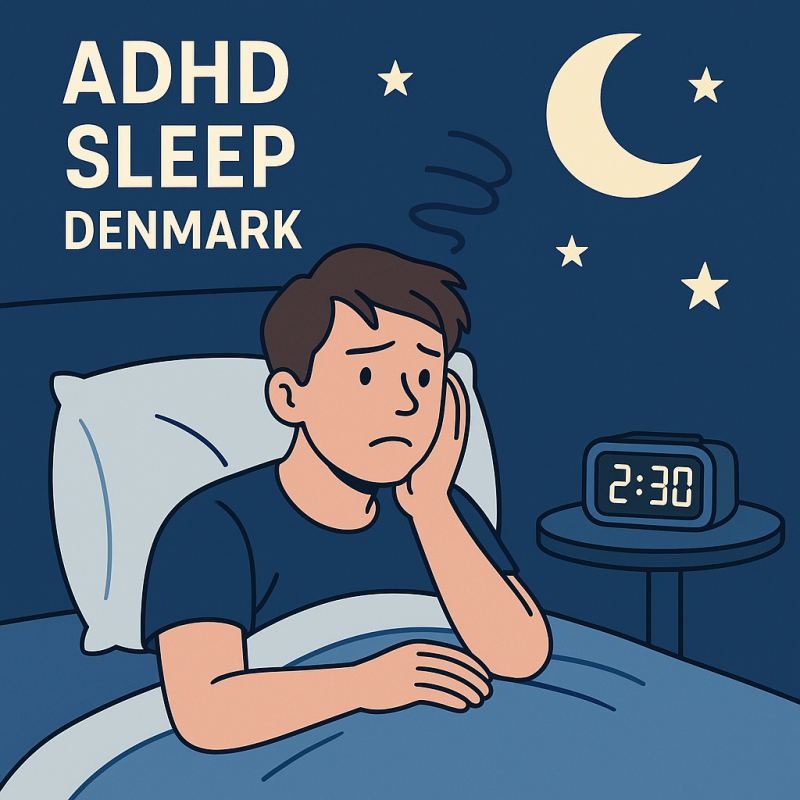ADHD
How to Sleep Better with ADHD: Tips Backed by Science (ADHD Sleep Denmark)
How to Sleep Better with ADHD: Tips Backed by Science
Getting a good night’s sleep can be a struggle for anyone—but for people with ADHD, it’s often a daily battle. In Denmark, more families and adults are seeking better ways to manage ADHD, especially when it comes to improving sleep. Scientific research shows that ADHD and sleep problems are deeply connected, but the good news is that better rest is possible with the right strategies.
In this blog post, we explore how to sleep better with ADHD, focusing on science-backed tips and what people in Denmark can do to find lasting solutions.
Why People with ADHD Struggle with Sleep
Studies show that up to 75% of people with ADHD experience chronic sleep problems. This includes difficulty falling asleep, staying asleep, or waking up too early. There are several reasons for this:
-
Delayed sleep phase: Many individuals with ADHD have a naturally shifted body clock, causing them to feel tired late at night and struggle with early mornings.
-
Overactive brain: ADHD can make it hard to shut off racing thoughts at night.
-
Medication timing: Stimulants like Ritalin or Concerta, commonly used in Denmark, can affect sleep if taken too late in the day.
-
Coexisting conditions: Anxiety, depression, and sensory sensitivities (common with ADHD) can interfere with sleep patterns.
Understanding these causes helps tailor better sleep strategies for people with ADHD in Denmark.
1. Create a Sleep Routine That Actually Works
Consistency is key. The brain loves routine—especially the ADHD brain. Going to bed and waking up at the same time every day, even on weekends, helps reset your internal clock.
Tip for Denmark: During winter, when daylight is limited, use a sunrise alarm clock or light therapy lamp in the morning to reinforce natural sleep-wake rhythms.
2. Limit Screen Time Before Bed
Research shows that the blue light from screens blocks melatonin, the hormone that helps you fall asleep. For people with ADHD, who may already have delayed melatonin release, this is even more harmful.
Science-backed tip: Avoid screens at least 1 hour before bedtime. If that’s not realistic, use blue light filters or glasses to reduce impact.
3. Use Melatonin with Caution
In Denmark, melatonin is available by prescription and is commonly used for children and adults with ADHD. Studies confirm that melatonin can help people with ADHD fall asleep faster, but it must be used under medical guidance.
Important: Never self-prescribe melatonin. Speak with your doctor to determine the right dosage and timing—typically 1-2 hours before bedtime.
4. Practice ADHD-Friendly Relaxation Techniques
Mindfulness, breathing exercises, and progressive muscle relaxation are proven to help calm the ADHD brain before bed. Apps like Headspace (available in Danish) and Calm offer guided sessions to help wind down.
Danish tip: Try pairing mindfulness with cozy hygge-style rituals like a warm herbal tea, a weighted blanket, or low lighting to make your routine more inviting.
5. Avoid Stimulants in the Afternoon
If you’re taking ADHD medication, caffeine, or consuming energy drinks, be aware of the timing. Stimulants can stay in your system for 6–8 hours, disrupting sleep onset.
Local tip: Many Danish students and workers rely on coffee during the day. Try switching to non-caffeinated options after 2 p.m. to reduce interference with your sleep cycle.
6. Exercise—But Not Too Late
Exercise can significantly improve sleep quality, especially for those with ADHD. However, intense physical activity too close to bedtime may energize the brain.
Best practice: Engage in aerobic exercise or strength training earlier in the day, ideally before 6 p.m. Walking, biking, or swimming are popular in Denmark and excellent for reducing stress and promoting sleep.
7. Design an ADHD-Friendly Sleep Environment
Your bedroom should promote calm and relaxation. Consider:
-
Blackout curtains (essential during long Danish summer days)
-
White noise or nature sounds
-
A cool room temperature (around 18°C is ideal)
-
Removing distracting clutter
Sensory tip: If you’re sensitive to sound or touch, try earplugs, weighted blankets, or soft bedding that suits your sensory needs.
8. Address Coexisting Conditions
If anxiety, depression, or sensory processing issues are also present (as is common with ADHD), it’s important to treat those in parallel. Many ADHD-friendly clinics in Denmark offer holistic care, combining behavioral therapy, medication, and coaching.
Trusted support: Platforms like ADHDlucidtrips.com can connect Danish residents to ADHD-specific solutions, supplements, and advice tailored to improving both focus and sleep.
Final Thoughts: Better Sleep with ADHD Is Possible
Improving sleep with ADHD takes time, patience, and the right strategies. If you live in Denmark and are struggling with sleep, know that you’re not alone—and there are science-based methods that work. Whether you’re a student in Copenhagen or a parent in Aarhus, adopting healthy sleep habits and working with professionals can make a big difference in your daily life.
Don’t give up—sleep success is achievable. Start with one or two tips and build from there. And always seek guidance from a doctor if your sleep problems persist.
For more ADHD sleep tips and resources in Denmark, visit ADHDlucidtrips.com—your trusted guide to ADHD wellness.

